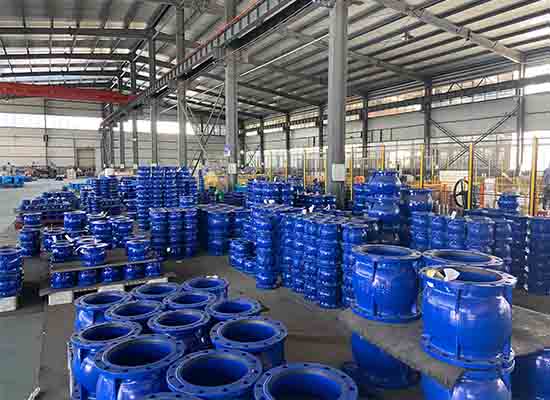In fluid piping system, valve is the control element, its main function is to isolate equipment and piping system, regulate flow, prevent backflow, regulate and discharge pressure.
Valves can be used to control the flow of air, water, steam, various corrosive media, mud, oil, liquid metal and radioactive media and other types of fluids. As the pipeline system to choose the most suitable valve is very important, so, to understand the characteristics of the valve and the selection of valve steps and basis has become very important.
Classification of valves:
One, the valve can be divided into two categories:
The first kind of automatic valve: rely on the medium (liquid, gas) its own ability and its own action of the valve.
Such as check valve, safety valve, regulating valve, trap valve, reducing valve and so on.
The second type of driving valve: manual, electric, hydraulic, pneumatic to control the valve action.
Such as gate valve, globe valve, throttle valve, butterfly valve, ball valve, plug valve and so on.
Two, according to the structural characteristics, according to the direction of the closing parts relative to the valve seat movement can be divided:
1. Closure shape: the closing part moves along the center of the seat;
2. Gate shape: the closing part moves along the center of the vertical seat;
3. Cock and ball: the closing part is a plunger or ball, revolving around its center line;
4. Swing shape: the closing parts revolve around the axis outside the seat;
5. Disc: the disc of the closed parts rotates around the axis of the seat;
6. Slide valve: the closing part slides in the direction perpendicular to the channel.
Three, according to the use, according to the different use of the valve can be divided:
1. Breaking use: used to put through or cut off the pipeline medium, such as globe valve, gate valve, ball valve, butterfly valve, etc.
2. Check: used to prevent backflow of media, such as check valves.
3 regulation: used to adjust the pressure and flow of the medium, such as regulating valve, pressure reducing valve.
4. Distribution: used to change the flow of medium, distribution medium, such as three-way cock, distribution valve, slide valve, etc.
5 safety valve: when the medium pressure exceeds the specified value, it is used to discharge excess medium to ensure the safety of pipeline system and equipment, such as safety valve and accident valve.
6.Other special uses: such as trap valve, vent valve, sewage valve, etc.
7.Four, according to the driving mode, according to the different driving mode can be divided:
1. Manual: with the help of hand wheel, handle, lever or sprocket, etc., with human drive, drive a large torque fashion worm gear, gear and other deceleration device.
2. Electric: driven by a motor or other electrical device.
3. Hydraulic: To drive with the aid of (water, oil).
4. Pneumatic: driven by compressed air.
Five, according to the pressure, according to the nominal pressure of the valve can be divided:
1. Vacuum valve: absolute pressure < Valves with a height of 0.1mpa, or 760mm hg, are usually indicated by mm hg or mm water column.
2. Low pressure valve: nominal pressure PN≤ 1.6mpa valve (including PN≤ 1.6mpa steel valve)
3. Medium pressure valve: nominal pressure PN2.5-6.4mpa valve.
4. High pressure valve: nominal pressure PN10.0-80.0mpa valve.
5. Super high pressure valve: nominal pressure PN≥ 100.0mpa valve.
Six, according to the temperature of the medium, according to the valve working medium temperature can be divided:
1. Ordinary valve: suitable for medium temperature -40℃ ~ 425℃ valve.
2. High temperature valve: suitable for medium temperature 425℃ ~ 600℃ valve.
3. Heat resistant valve: suitable for medium temperature above 600℃ valve.
4. Low temperature valve: suitable for medium temperature -150℃ ~ -40℃ valve.
5. Ultra-low temperature valve: suitable for medium temperature below -150℃ valve.
Seven, according to the nominal diameter, according to the nominal diameter of the valve can be divided:
1. Small diameter valve: nominal diameter DN< 40mm valve.
2. Medium diameter valve: nominal diameter DN50 ~ 300mm valve.
3. Large diameter valve: nominal diameter DN350 ~ 1200mm valve.
4. Oversized diameter valve: nominal diameter DN≥1400mm valve.
Viii. It can be divided according to the connection mode of valve and pipeline:
1. Flanged valve: valve body with flanged, and pipe with flanged valve.
2. Threaded connection valve: valve body with internal thread or external thread, threaded connection valve with pipeline.
3. Welded connection valve: valve body with welds, and pipes with welded valves.
4. Clamp connection valve: valve body with a clamp, and pipe clamp connection valve.
5. Sleeve connection valve: the valve is connected with the sleeve and pipeline.
Post time: Nov-11-2021


